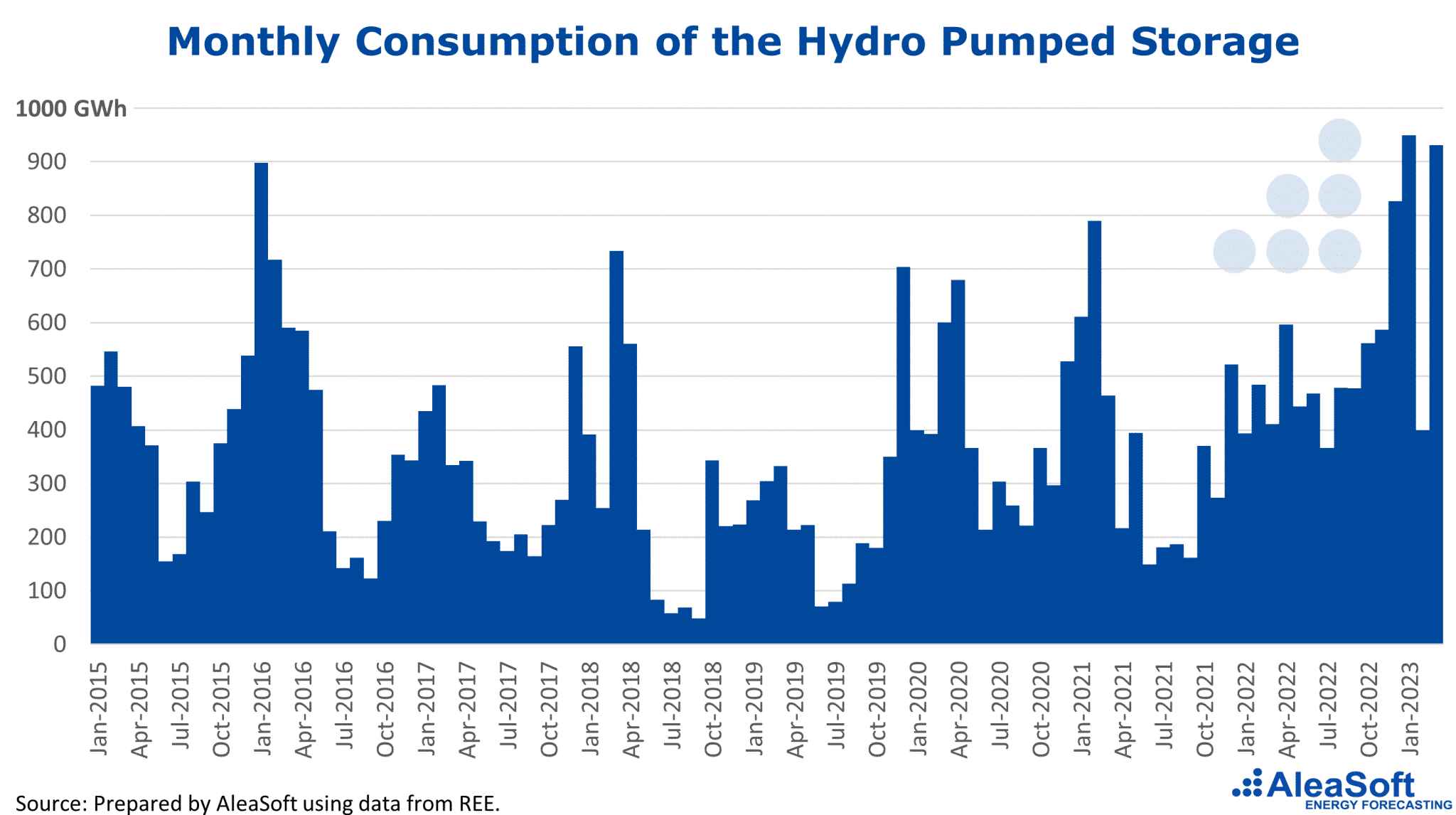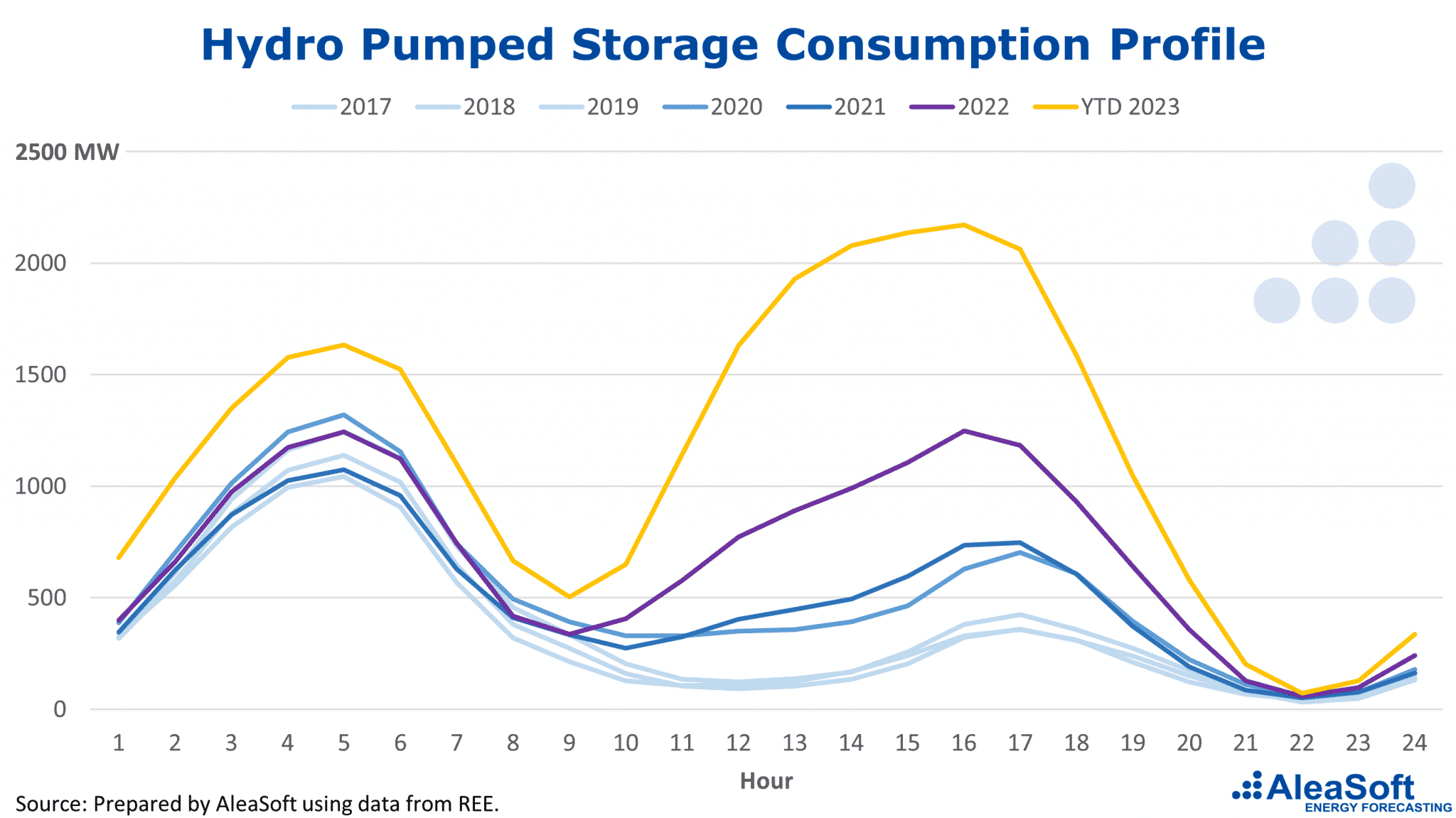AleaSoft Energy Forecasting, April 21, 2023. Hybridisation with energy storage will allow renewable energy plants to have the necessary management capacity to avoid curtailments and partially mitigate the price cannibalisation in the central hours of the day. The most important storage capacity in the Spanish electricity market is that of the pumping power plants, which in recent years have adapted their consumption profile to the low prices that photovoltaic energy is causing in the central hours of the day.
On past April 20, 2023, the 32nd edition of the series of monthly webinars organised by AleaSoft Energy Forecasting and AleaGreen took place with the participation of ASEALEN and Rolls‑Royce Solutions Berlin. The guests were Raúl García Posada, director of ASEALEN, and Javier Gebauer, Senior Manager at Rolls‑Royce Solutions Berlin. The last speaker only participated in the Spanish version of the webinar. In addition to the usual update on the evolution of the energy markets in Europe, during the webinar both technical and regulatory, economic and financial issues of batteries, as well as of energy storage systems in general, were addressed.
Energy storage in the energy transition
That energy storage with batteries and hydrogen will be essential in the energy transition is no longer surprising news. In any case, the news would be why it is taking so long to implement it on a large scale, now that wind energy and, above all, solar photovoltaic energy are reaching levels where their erosion of the thermal gap is already having a very clear impact on electricity markets prices.
Energy storage is the essential complement for renewable energies such as wind and solar photovoltaic energy. Storage will make these energies manageable, will allow energy not to be wasted with curtailments, and will avoid a dramatic cannibalisation of prices in the electricity markets.
Energy storage in Spain
In recent weeks there has been a notable number of news stories about how large companies are already beginning to design battery projects for the Spanish electricity system. But if we talk about the present, the storage of energy of the grid in Spain is carried out by reversible hydroelectric plants, commonly known as pumping power plants. These plants are capable of consuming energy from the electricity grid to pump water from a lower reservoir to another reservoir located at a higher altitude, to, at a later time, drop the water back into the lower reservoir and generate electricity with a turbine. All this with efficiency close to 70%.
During the webinar, Raúl García Posada showed how in the summer of 2022 pumping stored more energy than in any other summer, and so far in 2023 very high values are also being registered. According to the director of ASEALEN, pumping has gone from having a marginal role in the Spanish electricity system, to actively participating with its energy storage capacity.

This change in the role of pumping has been possible thanks to the price spread that has appeared in the hourly prices of the Iberian electricity market. In the hours when the price is set by combined cycle gas turbine power plants, prices are high due to the high gas and CO2 prices, while, in the most central hours of the day, when renewable energies can set the market prices, prices fall to very low values. In this way, pumping power plants can consume energy at low prices and produce it again at times when prices are clearly higher.
For his part, Oriol Saltó i Bauzà, Associate Partner at AleaGreen, showed how the consumption profile of pumping power plants in Spain has changed radically in recent years. Historically, the lowest prices in the Iberian electricity market were registered at dawn, when the demand was lower. The pumping power plants took advantage of those hours to consume most of their energy at competitive prices.

Since 2020, this consumption profile focused on the early morning hours began to change. As the increase in photovoltaic energy production began to push prices in the central hours of the day towards lower values, pumping began to consume more in those hours, and so far in 2023, the profile is practically reversed, with most of the consumption concentrated in the hours with the highest solar energy production.
The hybridisation of storage with renewable energies
In addition to stand alone battery installations, isolated battery systems directly connected to the electricity transmission grid, where storage will play an important role will be in wind and photovoltaic power plants, which will be hybrid plants of renewable energy and storage.
The hybridisation of storage with renewable energies will allow the latter to gain management capacity for the energy they produce. Both wind and photovoltaic energy can only produce when their resource, wind or solar radiation, is present. With the presence of batteries, or other storage systems, in the same renewable power plant, it will be possible to store part of the energy produced when it is excessive and inject it into the grid when there is less production or more demand.
This management capacity will allow largely avoiding renewable energy curtailments that can occur due to the impossibility of injecting all produced energy into the grid. It will also allow storing part of the energy to inject it at a later time with better prices. This will be especially important for photovoltaic power plants, since it will allow avoiding excessive price cannibalisation in the central hours of the day.
With all this, hybridisation with energy storage will make renewable power plants more efficient and it will increase their income from the sale of energy, although this will come with a higher initial investment cost.
In order to correctly dimension the size of a battery installation in a renewable power plant, long‑term price forecasts with hourly granularity are necessary, that is, hourly price forecasts with a horizon that covers the lifetime of the plant, between twenty and thirty years typically. The hourly price forecasts allow making an estimate of the income from the sale of energy and a correct optimisation and dimensioning of the installation taking into account both the evacuation capacity of the plant and the hourly wind or photovoltaic energy generation.
AleaSoft Energy Forecasting’s analysis on the prospects for energy markets in Europe and the valuation of renewable energy assets
The next edition of the series of monthly webinars will take place on May 11, 2023 and the Spanish version of the webinar will include the participation of Luis Atienza Serna, who was Minister of the Government of Spain and, later, President of Red Eléctrica de España (REE), who will contribute his interesting vision on the future of the energy sector in both Europe and South America, where he also has professional experience.
Source: AleaSoft Energy Forecasting
